| 1 | Great Basin rattlesnake |
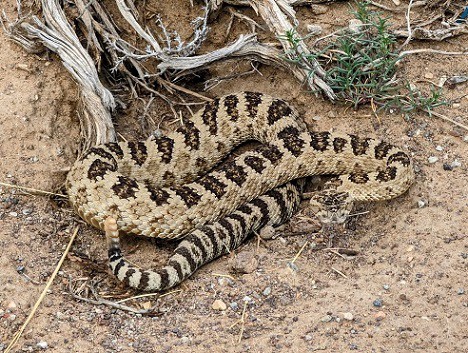
Easily the most common venomous snake in Nevada. While sidewinders and Mojave rattlesnakes inhabit the south of Nevada, Great Basin rattlesnakes inhabit the vast majority of the state. The only area they skip is the far south near Las Vegas (i.e. most of Clark County).
This rattlesnake measures 65-120cm, with a maximum of 134.6cm, and is actually a subspecies of the widespread Pacific rattlesnake. Great Basin rattlesnakes (Crotalus oreganus lutosus) inhabit chaparral, semi-deserts with cacti, and dry rocky areas covered with shrubs. Any truck driver pulling over at a scenic rest stop with picnic benches has a strong chance of meeting this species.
Hikers commonly meet this snake, and bites are reasonably common. A study using data from the North American Snakebite Registry found that 12 proven bites occurred from 2013-2015, which was the second highest across the 14 states tested, beaten only by the western diamondback at 18 bites. A 2016 study identified an all new myotoxin (muscle-shredding toxin) from Great Basin rattlesnake venom, called ColTx-I.
The further north you drive from Las Vegas, the stronger your chances of meeting this dangerous rattlesnake. A debate is ongoing as to whether Crotalus oreganus lutosus is a fully independent species, which would simply be titled Crotalus lutosus instead. Either way, the Great Basin rattler is physically distinct from the main Pacific rattlesnake, with brown or black blotches contrasting especially sharply against a beige base. This makes for perfect camouflage in the parched desert landscapes where they hang out.
| 2 | Ground snake |
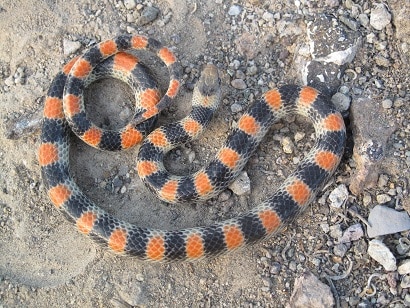
A harmless snake measuring just 25-45cm, with a record of 48.3cm. The ground snake (Sonora semiannulata) is non-venomous, but has the special feature of preying on insects and other creepy crawlies. Confirmed prey for the ground snake include centipedes, scorpions, insect larvae, and even spiders.
Ground snakes are most concentrated in southern Nevada, but are also found across most of the west. Sightings are plentiful around the outskirts of Las Vegas (south) and Reno (west). They’re also found in southern California and most of Arizona. This is a snake of intermediate areas. While they appear in semi-arid deserts, ground snakes require habitats with at least some moisture, such as dry grassland and shrubland, dried out streambeds, and open rocky hillsides.
Ground snakes have no way to defend themselves, and are popular prey for many predators. These include fellow snakes such as the Baja California rattlesnake, Sonoran coral snake and sidewinder rattlesnake (common in southern Nevada).
The ground snake is also one of the USA’s most variable snakes in colour. Grey and orange is typical, but shades of red and snowy white are also found. The patterns vary as well, with some arranged in stripes rather than bands, and others being a single colour. These morphs aren’t distinct subspecies, and freely intermingle in the same locations, without blending together and losing their distinctiveness.
| 3 | Mojave patchnose snake |
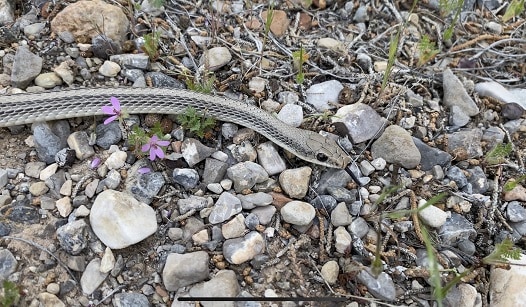
A common snake in the south of Nevada, including the outskirts of Las Vegas. The Mojave patchnose snake was named after a single, massively enlarged scale on the front of its nose, which is theorised to be for digging up buried lizard eggs. From head on, this patch is shaped like a human molar tooth.
This species is completely non-venomous, and averages at 65-90cm with a record of 104.1cm. Mojave patchnose snakes (Salvadora hexalepis mojavensis) have large eyes with round pupils, and smooth scales to touch. They’re mainly a creature of semi-deserts, and dry, wispy grassland with hardy shrubs.
For humans, this species is most commonly found along the edges of highways. Digging isn’t their only skill, as Mojave patchnose snakes are fast-moving, and able to skirt away from curious human beings in no time. They sometimes climb small desert shrubs in pursuit of prey, and have the ability to withstand extreme conditions, moving even during the day when the desert is at its most scorching.
This is actually a subspecies of the western patchnose snake (S. hexalepis), which is common across the southwestern US. Mojave patchnose snakes (Salvadora hexalepis mojavensis) are the most northerly of the 3 subspecies, and are the only one found in Nevada. The biggest difference is that the stripes down its back are more muffled, and less sharply defined than its fellow subspecies.
| 4 | Great Basin gopher snake |
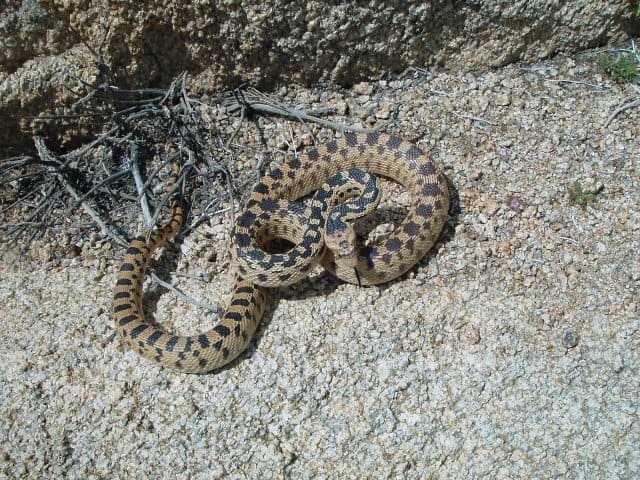
One of the few snakes to be found in every corner of Nevada. The Great Basin gopher snake (Pituophis canifer deserticola) is a subspecies of the wider gopher snake, and averages at 135cm, with a record of 185.4cm. They can be found near Las Vegas to the south, Reno to the west, and all the arid desert landscapes inbetween.
While technically a mere subspecies, Great basin gopher snakes are highly distinctive in appearance, with connected dark blotches contrasting vividly against a lighter undertone. With a triangular head and complex patterns, Great Basin gopher snakes are commonly mistaken for rattlesnakes and killed out of fear. In reality, they’re harmless – they might rear up, hiss loudly and perform bluff strikes, but they lack any venom and rarely bite.
The reason this species has conquered every corner of Nevada is its flexibility. Great Basin gopher snakes can inhabit semi-deserts, woodlands and grasslands with equal ease. Like the main gopher snake, their main foodstuff is mammals. A 2011 study found meadow voles (Microtus family) in their belly, while their own predators include fish, as observed in a weird event from 2006, where a 60cm brown trout attempted to swallow a 90cm Great Basin gopher snake by a stream.
| 5 | Striped whipsnake |
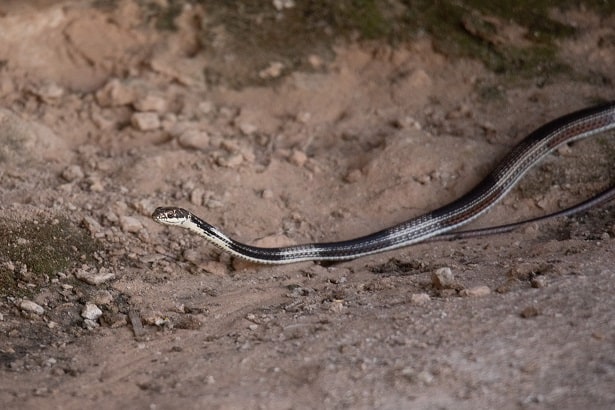
An extremely fast and thin snake, which reaches a maximum of 199cm. Striped whipsnakes are easy to recognise, as no other species in Nevada is quite as long and whip-like, except the red coachwhip, with is red rather than dark grey.
Striped whipsnakes are found across virtually all of Nevada, from Clark County in the south to the parched deserts of Nevada’s north. They shun urban zones, preferring to inhabit wide open grassland, spacious woodlands and semi-desert, where they’re commonly found slithering over dry rocky areas, sometimes close to streams.
The striped whipsnake (Mastichopis taeniatus) has a split personality. In some cases, they’ll snap and lunge viciously at anyone that dares to invade their personal space, but others will flee across the horizon at high speeds, vanishing up a shrubby hillside. A handful will stay still, but Masticophis taeniatus is an energetic snake which dislikes inaction.
Striped whipsnakes primarily eat lizards, which are plentiful in the parched landscapes of Nevada. They also eat fellow snakes, and their confirmed prey includes eastern racers, gopher snakes, patchnose snakes, ground snakes, and western diamondback rattlesnakes. To shelter themselves in the harsh Nevada terrain, striped whipsnakes often take shelter in rocky outcrops and vacant mammal burrows. This species is a close relative of the California whipsnake (Masticophis lateralis).
| 6 | Terrestrial garter snake |
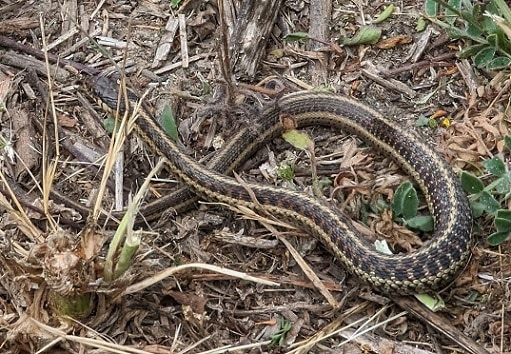
The US is full of garter snakes, but this is easily the most abundant species in Nevada. Terrestrial garter snakes (Thamnophis elegans) average at 50-100cm, with a maximum of 109.2cm. They’re also known as the wandering garter snake, and Nevada is just another vast open landscape that they’ve wandered into.
Terrestrial garter snakes are little threat to humans, but possess the strongest venom of the Thamnophis genus. Picking one up may land you with a swollen finger and throbbing pain for several days. They also have rare constriction abilities, and may decide to coil around your arm and squeeze.
The reason this species is so common in Nevada is that compared to other garter snakes, they’re less dependent on streams and ponds. They’re able to inhabit dried, more parched areas such as wispy grassland and rocky hillsides. Meanwhile, the common garter snake (Thamnophis sirtalis) is the most common species nationwide, inhabiting 47 out of 48 lower states (excluding Arizona). Common garter snakes inhabit Nevada as well, but only the extreme west, spilling over the border from California. Meanwhile, terrestrial garter snakes are found across a huge swathe of Nevada, especially the northern half.
Another reason is their more flexible diet, as terrestrial garter snakes prey on mammals, frogs and fish alike, rather than primarily amphibians. There’s also a third garter snake species in Nevada – the Sierra garter snake, found only in the moist far west.
| 7 | Desert nightsnake |
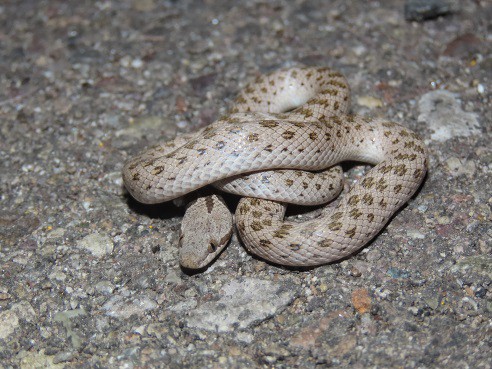
One of Nevada’s shiest snakes. The desert night snake (Hypsiglena chlorophaea) combines nocturnal habits with a tendency to appear in steep rock fields, where most human beings would stumble and cut their knees open within minutes.
This mostly harmless species ranges from northern Mexico to extreme southwest Canada. On the way, they stop off in Nevada, where they cover a large part of the state, especially the outskirts of Las Vegas. Hypsiglena chlorophaea is most commonly found in rocky environments, where they crawl through the endless nooks and crannies, following subtle lizard scent trails which no human being could possibly hope to detect. This is an extremely difficult snake to spot, due to their beige-grey colours that blend perfectly with stone.
Desert night snakes are fully nocturnal, as evidenced by their sharply vertical pupils. Jumbled rock fields by the sides of highways are one of their favourite habitats. This is a classic species which people may drive past regularly, but never once lay eyes on.
Night snakes have a mild venom, which likely causes no harm to humans. This is secreted by the rear fangs of their upper jaw, which are enlarged compared to their other teeth. This 40-60cm (maximum 64.2cm) species is one that a lifelong Nevada citizen may never encounter.
| 8 | Western leaf-nosed snake |
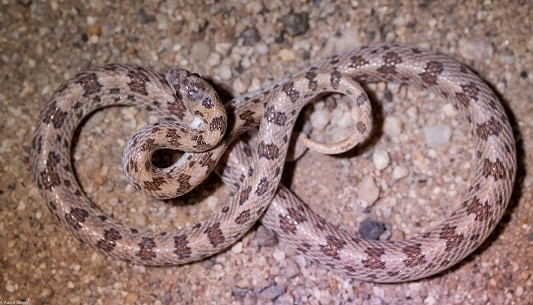
A species of harsh, arid deserts, which stops only at living in fully-fledged sand dunes. Western leaf nosed snakes (Phyllorhynchus decurtatus) inhabit barren deserts with no settlements, in areas such as open desert flats, washes and desert foothills. They have a strong correlation with creosote bushes, and the best place to spot them is on paved roads through the desert.
Spotted leafnose snakes are most common in the deserts of southern Nevada. Many weekend revelers will have driven past them on desert highways, bleary eyed after a manic 3 day holiday in Vegas which they vow never to mention again. Spotted leafnose snakes are excellent diggers, with an enlarged frontal scale on their snout similar to the patchnose snake. They range from 30cm to a maximum of 51cm, and combined with their beige-brown camouflage, this makes spotting them extremely difficult. From a speeding car, it’s virtually impossible.
Though no real threat, western leaf-nosed snakes are no pushover, as they sometimes draw back and strike at curious onlookers. They possess no venom capable of harming humans, but they do have one secret weapon – if you’re in a desert harsh enough to contain them, there’s a strong chance that a sidewinder rattlesnake will creep up behind you while you’re distracted.
| 9 | California kingsnake |
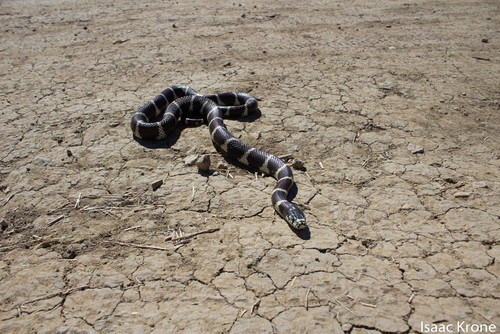
A super constrictor which lacks even a drop of venom. California kingsnakes are one of the most common species in their namesake state, but they also have a strong colony in southern Nevada. They’re abundant in the regions near Las Vegas, and live further north as well, with scattered sightings near places like Austin (population 167).
California kingsnakes are a hardy and tough species, with the honour of being the most efficient constrictor in the known world, coiling around their mammal prey in an extremely tight formation. According to a study examining over 2000 preserved specimens, their diet consists of 29% mammals, 29% fellow snakes and 15% lizards. Fellow snakes on their menu included gopher snakes, coachwhips, sidewinders, and Great Basin rattlesnakes. Many of these species live in Nevada.
California kingsnakes average at 76-107cm, with a record on the US mainland of 142.2cm (on some islands they can reach 2 metres). They’re one of Nevada’s most recognisable species, with vividly contrasting black and white patterns. California kingsnakes are highly flexible in their habitats, and can inhabit semi-deserts with wispy grass, open rocky hillsides and dry woodlands alike. Rather than an ambush predator, they’re an active forager, which relentlessly prowls around the Nevada wilderness, investigating any slight scent its constantly flecking tongue picks up.
| 10 | Red coachwhip |
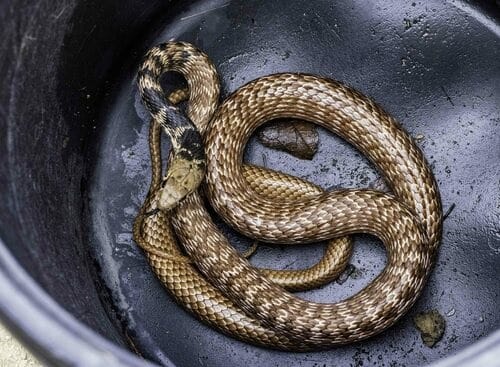
The coachwhip is an extremely common snake of the US, ranging from California in the west to Florida in the east, and spilling into northern Mexico. There are 8 subspecies, and the red coachwhip (Masticophis flagellum piceus) is Nevada’s main version. It’s one of the most recognisable subspecies, with a red body and black-white neck patches.
Red coachwhips belong to the same Masticophis genus as striped whipsnakes, and have a similar nature. They’re twitchy, fast, alert, and energetic snakes which will snap at you one minute, then vanish into undergrowth the next. Coachwhips are renowned as one of the world’s fastest snakes, and catching one in your hands is an epic task.
Red coachwhips inhabit a decent chunk of Nevada, skipping the northeast, while having a strong grip on Las Vegas and western areas near Reno. They’re the only subspecies to inhabit Nevada, and are one of Nevada’s longest snakes. The official record for this subspecies is 172.8cm, but it’s highly likely that they exceed 2 metres. The record for the coachwhip as a whole is 259.1cm.
Red coachwhips hate areas of dense vegetation, as this impedes their speedy movements. Otherwise, they’re extremely flexible, inhabiting semi-desert, open grassland, and rocky hillsides alike. Lizards form the bulk of their diet, and they’re famous for their high tolerance of scorching heat.
